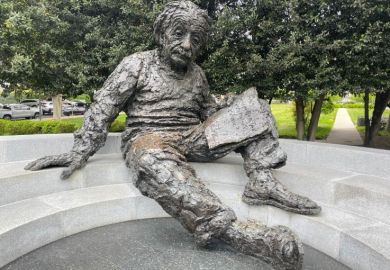Palaeopathologists are the bone boffins of modern archaeology, scouring ancient skeletons for signs of disease. It is a hard and frustrating pursuit. After burial, most of the obvious marks of disease are quickly lost as soft tissue decomposes. Only a tithe of humanity's disease burden can be read from the chalky residue that sometimes survives.
Most obvious are diseases of the joints, such as arthritis, and the breaks, fractures and dents that humans acquire. Then come a few congenital diseases - cleft palate, clubfoot - and those few infectious diseases that mark bones - leprosy, tuberculosis, syphilis and polio - although the evidence is easily missed. TB, for example, affects the skeleton in only 5 to 7 per cent of cases - and then that part needs to survive and needs the archaeologist to notice it. With care and an X-ray machine, ecological stresses can also be measured from the mineral or vitamin deficiencies they cause. Oddly, the hardiness of teeth means that it is dental diseases that are most obvious; we know surprising amounts about Mesolithic oral health. The archaeological net has been gradually broadened as the genetic make-up of ancient bacilli has become technically accessible. One of palaeopathology's major news stories recently was the discovery of plague bacillus DNA in a medieval skeleton.
From skeletons we can start to build a partial account of human health in the past that is free of the interpretative horrors of retrospective diagnosis from ancient texts or the dubious efficacy of analogies with modern "primitive" societies. Admittedly, the skeleton is a complex signifier - often hinting at a multitude of potential causative disorders or an ambiguous multifactoral origin - but open questions are better than none.
Yet, despite decades of work, palaeo- archaeology is in a mess. As this book records, the data source is biased by poor recording and flawed interpretation as much as by the inevitable constraints of survival and recovery. Misdiagnosis or underdiagnosis is common as inexperienced researchers grapple with evidence that is never less than highly complex.
Too much attention is still paid to unusual individual diseases, too little to the population at large. Tellingly, Charlotte Roberts and Margaret Cox found not a single archaeological report - even their own - had the full range of information they needed when writing this book.
Palaeoarchaeology is also under outside pressure. An international debate on the ethics of keeping human remains threatens to return its source material to the ground; some bodies are already being reburied without adequate reporting. This issue is most acute for foreign remains; the UK Human Remains Working Group recently recommended the creation of a system to repatriate bones. However, the Church of England is pushing for similar moves within the UK, and the Museum of London's announcement in January that it wants to rebury most of the 17,000 skeletons in its collection suggests that the tide is turning against the palaeoarchaeologists.
In this book, Roberts and Cox have produced a blend of quiet polemic and synthetic scholarship that serves both as a warning and a promise of future riches. Its scope is ambitious: to provide an account of human health and disease from prehistory to the present day, integrating palaeoarchaeology with the other archaeological, anthropological and historical evidence about the disease ecology of Britain. The success of this approach is limited. Readers looking for a survey on health, environment and medicine will probably go elsewhere, and the text at times is in need of a good editor. But the archaeological evidence is endlessly informative. They consider evidence about the remains of 34,797 individuals from 311 sites spanning 12,000 years; tables detail everything from rates of dental caries in Roman England to evidence of congenital disease in the long 18th century.
There are some striking findings. The move from hunting to agriculture was accompanied by a gradual increase in joint disorders, probably due to labour, and a decline in dental health. Roman Britain comes out as particularly ill starred, seeing the first appearance in the skeletal record of gout on the one hand and scurvy, rickets and tuberculosis on the other. In contrast, in the "dark ages" average stature increases and dietary disorders decline, perhaps as a result of a more basic agrarian diet. While impressions of portly medieval friars seem to be substantiated by the relatively high prevalence of diffuse idiopathic skeletal hyperostosis (Dish) - a condition associated with obesity and late-onset diabetes - in monastic graveyards, some older assumptions are challenged, particularly by evidence that syphilis was present in Britain before the Columbian exchange.
After 1550, rates of sinusitis, a condition linked to atmospheric pollution, fell despite the rise in complaints about urban smog; the reduced rate of lower-arm and mandibular fractures suggests less fighting, while the dramatic reduction in incidence of bunions indicates improvements in footwear. More surprisingly, despite increased urbanisation and industrialisation, average stature remains roughly the same and dental abscesses decline - although this may be an artefact of a middle-class sample for the later period.
So far, so fascinating. Yet, the limits of interpretation are clear. With very few exceptions - "shoemaker's thigh" in medieval Londoners who rested lasts on their legs, or "archer's shoulder" among the crew of the Mary Rose - evidence of occupational wear and tear is too diffuse to be linked to particular kinds of work. Similarly, while changes in diet can be identified pretty well, palaeopathology has little to say about the effects of social status, epidemics and warfare, which Cox and Roberts identify as the most significant influences on medieval human health. More frustratingly, without sufficient data about source populations and incidence, assessments of whether material is significant are often impossible.
Cox and Roberts have, nonetheless, set a marker for the direction of palaeopathology and biological anthropology. The potential of taking a population approach is clear, and this book is a cry for the decent records, better dissemination and closer collaboration that can allow it to move forwards. There are signs, such as the establishment of the British Association for Biological Anthropology and Osteoarchaeology in 1999, that this may be happening. As pressure for reburials grows, there is little time for dallying.
Patrick Wallis is lecturer in history, University of Nottingham.
Health and Disease in Britain: From Prehistory to the Present Day
Author - Charlotte Roberts and Margaret Cox
Publisher - Sutton
Pages - 476
Price - £25.00
ISBN - 0 7509 1844 6
Register to continue
Why register?
- Registration is free and only takes a moment
- Once registered, you can read 3 articles a month
- Sign up for our newsletter
Subscribe
Or subscribe for unlimited access to:
- Unlimited access to news, views, insights & reviews
- Digital editions
- Digital access to THE’s university and college rankings analysis
Already registered or a current subscriber? Login



